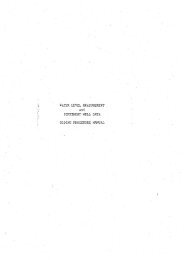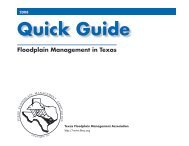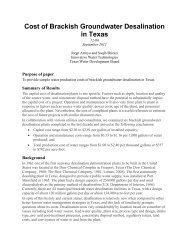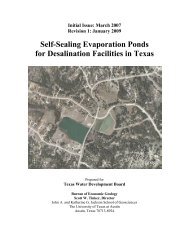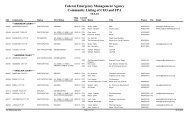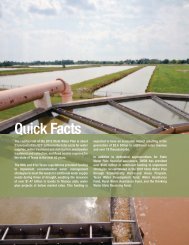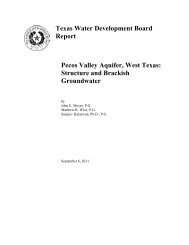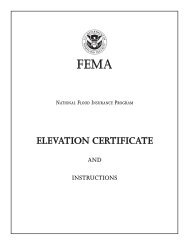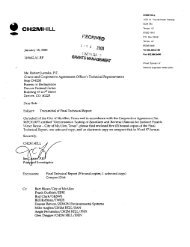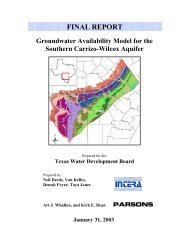Intensive Survey of the Guadalupe River Segment 1806
Intensive Survey of the Guadalupe River Segment 1806
Intensive Survey of the Guadalupe River Segment 1806
You also want an ePaper? Increase the reach of your titles
YUMPU automatically turns print PDFs into web optimized ePapers that Google loves.
PERIPHYTON<br />
Periphyton are collected from streams and reservoirs from natural sub<br />
strates or from artificial substrates placed in <strong>the</strong> water. Standard<br />
size, frosted microscope slides are commonly used as artificial sub<br />
strates and are held in place a few centimeters beneath <strong>the</strong> water surface<br />
at <strong>the</strong> sampling sites in floating periphytometers. Following a 25 to 30<br />
day incubation period <strong>the</strong> accrued materials are analyzed for chlorophyll a_,<br />
pheophytin a^, and for identification and enumeration <strong>of</strong> <strong>the</strong> attached<br />
organisms.<br />
In <strong>the</strong> field, following retrieval <strong>of</strong> <strong>the</strong> periphytometer, two slides are<br />
placed in a brown glass container containing 100 ml <strong>of</strong> 90 percent aqueous<br />
acetone. The material from <strong>the</strong>se two slides is used for pigment measure<br />
ments. Two slides are placed in ano<strong>the</strong>r brown glass container containing<br />
100 ml <strong>of</strong> 5 percent buffered formalin. The material from <strong>the</strong>se two slides<br />
is used for biomass measurements. The remaining slides are also placed in<br />
buffered formalin and utilized for identification and enumeration <strong>of</strong> organ<br />
isms according to procedures discussed for <strong>the</strong> phytoplankton. The brown<br />
glass jars containing <strong>the</strong> material for laboratory analyses (pigment and<br />
biomass measurements) are placed in a deep freeze and kept frozen prior to<br />
analysis.<br />
The autotrophic index is calculated accordina to <strong>the</strong> equation given by<br />
Weber and McFarland(9).<br />
a 4. 4. u- i a Biomass (g/m2)<br />
Autotrophic Index = ^—-<br />
Chlorophyll a^ (g/m2)<br />
Periphyton samples may also be collected from natural substrates by scraping<br />
areas from each type <strong>of</strong> substrate available at each sampling location.<br />
Scrapings are made from a range <strong>of</strong> depths from subsurface to <strong>the</strong> stream<br />
bottom, from bank to bank, and at points spanning <strong>the</strong> range in stream<br />
velocity. The scrapings from each sampling location are composited into<br />
a container, preserved with Lugols solution and returned to <strong>the</strong> laboratory<br />
for identification and enumeration following procedures discussed in <strong>the</strong><br />
phytoplankton section. Diversity, redundancy, and equitability statistics<br />
are calculated as described previously.<br />
PLANKTON<br />
Phytoplankton<br />
Stream phytoplankton are collected immediately beneath <strong>the</strong> water surface<br />
with a Van Dorn sampler or by immersing a sampling container. Phyto<br />
plankton samples are collected with a Van Dorn water sampler at depths<br />
evenly spaced throughout <strong>the</strong> water column <strong>of</strong> reservoirs.<br />
A-9




